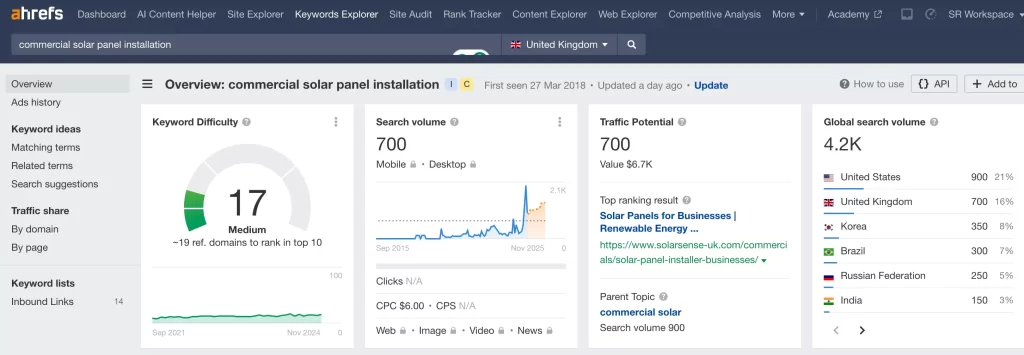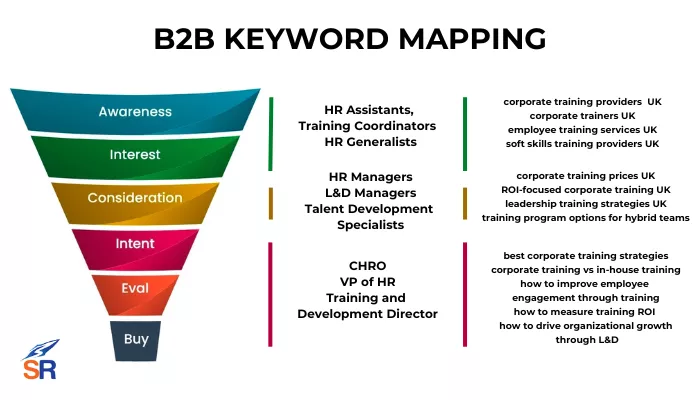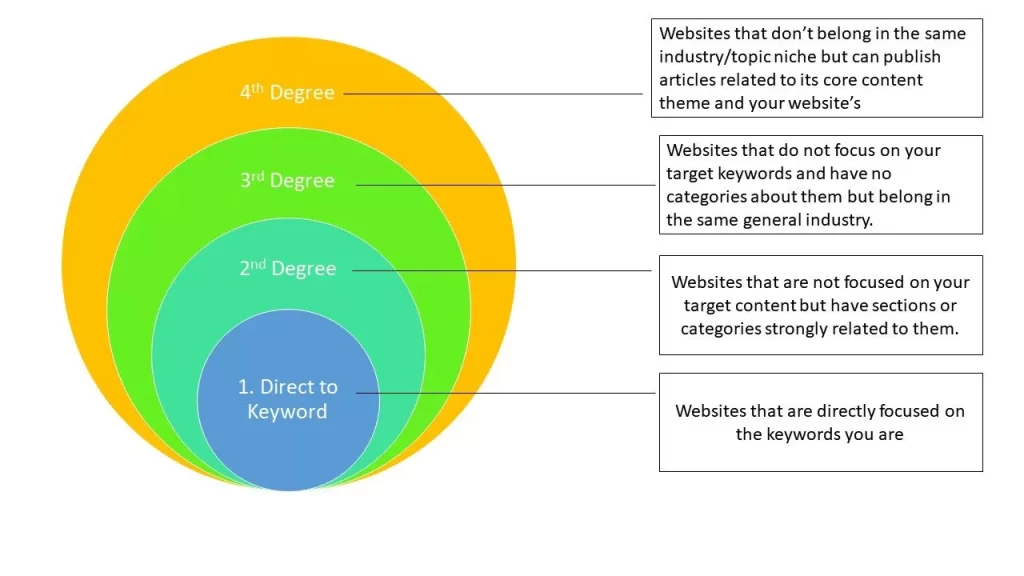B2B companies are increasing their budgets and investing heavily in SEO and content strategy like never before.
In fact, if you run an SEO agency, B2B SEO is one of the most lucrative types of campaigns you can deal with, as the few leads they acquire from search correspond to their monthly SEO investment.
Consider one client closed for a commercial solar panel worth thousands of dollars—a few clients of this sort justify their investment in SEO.
While most SEOs are familiar with running B2C SEO campaigns targeted at regular consumers (e.g., eCommerce SEO), B2B SEO has many nuances in its decision-making process and customer journey, which are both critical to developing the right SEO strategy and link building.
Why B2B SEO Requires a Unique Approach?
Lower Search Volumes, Higher Traffic Value
Unlike B2C markets, B2B keywords often attract lower search volumes.
However, these keywords represent users further along the buying journey and are ready to make high-value decisions.
For instance, consider the traffic value for this specific keyword, “commercial solar panel installation,” at $6.7K (not to mention the traffic value of its other keyword variants).
Longer Sales Cycles
B2B buyers typically go through extended research and evaluation phases. So, your SEO strategy must support users throughout the funnel—from initial awareness to final purchase decisions.
You can’t simply rely on typical keyword research. You have to map out the entire buyer cycle for stakeholders and the keywords they may be searching for, depending on their current roles.
Multiple Stakeholders
B2B decisions involve a variety of roles and perspectives.
Creating content that addresses the needs of different stakeholders—decision messengers, influencers, and decision-makers—ensures relevance and increases the chances of conversion.
Unlike B2C, where you target individual consumers, B2B SEO involves a variety of roles. Therefore, expanding your reach with your content strategy would be crucial in significantly increasing search traffic and conversions.
Now, let’s take a look at key fundamentals in B2B SEO.
1. Understand the Business, Stakeholders, and Decision Makers
You can’t start any B2B SEO campaign without knowing the intricacies of the client’s business you’re serving with. Effective B2B SEO begins with understanding the client’s business and the key players in the buying process.
As mentioned earlier, unlike B2C decisions that may involve a single buyer, B2B purchases require collaboration between multiple roles, including decision messengers, influencers, and final decision-makers.
Let me give you tips on how to develop a deeper understanding of your client’s business:
Conduct Consultations and Meetings
Start by meeting with internal subject matter experts (SMEs) and product managers of the client’s company. Discussions with them will provide insights into the business’s goals, products, and unique selling points. They can also help you gather information about the typical customer base and their challenges.
You can develop worksheets to organize data and information as you accumulate them during your consultation. This approach is not one-time meetings but consistent consultations to better understand their client base, product offerings, and how search could help them acquire new leads.
Beyond keyword research, you should go exactly to the points of your client’s target market. This will later translate into a better content strategy and format for the blog, which you will strategically publish.
Listen to Sales Calls and Review Proposals
Sales calls and proposals are rich sources of industry-specific jargon and standard terms potential buyers use. Familiarizing yourself with this language ensures your content resonates with its target audience and meets their expectations.
I recommend this highly when you’re doing SEO for B2B SaaS, where the majority of the sales activities are done in calls and software presentations. Recording these sales calls, assessing them, and seeing patterns better can help you craft your messaging on your content assets.
You can use AI tools such as Fireflies.ai, which we maximize in our sales calls at Rainmakers. It integrates directly with Zoom and summarizes the meeting, giving me actionable items and important notes during the meeting.
Review New-Hire Onboarding Materials
New-hire onboarding materials often include valuable overviews of the company, its products, and its market position. These resources can also clarify the product’s features and benefits, key messaging points, and buyer personas. If the client can provide this, it would add insights to your B2B SEO campaign.
Get a Demo Walkthrough
Request a demo walkthrough of the product or software. This hands-on experience is critical for understanding how the product works, who uses it, and the problems it solves.
Similar to what I’ve mentioned earlier, these demo walkthroughs can deepen your understanding of the client’s business by giving you a feel for the emotions, reactions, questions, and actual conversations with their existing clients (this later helps in crafting content for the intent, evaluation, and buy stages of the B2B sales cycle).
Understand Key Decision Makers
In B2B buying processes, roles are segmented into:
- Awareness and Interest Stage: Tactical-level employees and field operators who act as decision messengers.
- Consideration Stage: Mid-level managers who influence purchasing decisions and provide recommendations.
- Intent and Evaluation Stage: Senior executives or department heads who make the final call.
Understanding who holds the most influence at each stage is critical for crafting content that speaks to their unique needs.
For instance, my corporate training company usually deals with HR and Learning and Development practitioners at different rank levels. Then, align each role at each buyer stage.
To give you an example, here’s what key decision-makers look like at each stage:
- Awareness and Interest Stage: HR Assistants, Training Coordinators, and HR Generalists
- Consideration Stage: HR Managers, Learning and Development (L&D) Managers, and Talent Development Specialists
- Intent and Evaluation Stage: Chief Human Resources Officer (CHRO), Vice President of HR, and Training and Development Director
Map Out Keywords To Key Decision Roles
The tangible output from identifying key decision roles is a mapped-out keyword plan these critical people of your client’s target market are searching for.
Below is an example of the different sets of keywords these roles are using to find solutions in the corporate training industry:
You’ll notice an interesting pattern here. For example, in the Awareness and Interest stage, HR assistants and the like are directly looking for specific solutions—corporate training providers—given that their tasks are mainly to find potential training providers based on certain qualifications.
As you move below the buyer stage (Intent and Evaluation Stage), key roles, such as the VP of HR or Training and Development Director, are more interested in the business impact of a training program—at most, all C-Suite and top management-level roles consider the significant impact of any activity on the organization’s bottom line.
As roles move up the ladder, they change their search queries based on the context of their work.
Prioritize Keywords Based on a Deep Understanding Of The Stakeholders’ Decision-Making Process
Having a limited budget and resources for B2B SEO campaigns requires strategizing a content campaign that will best yield a quick return (low-hanging fruit SEO strategy).
So, instead of mapping out your content calendar every keyword in each buyer stage and publishing content around all of them. It’s a better use of resources to think first about which decision roles best or highly influence the decision-making process.
This is a case-to-case basis, from industry-to-industry and business-to-business assessment, so having a deep understanding of your client’s business is crucial here.
For instance, in my earlier example of hiring a corporate training provider, most of the decisions come from the lower ranks to mid-level management. After the HR assistant qualifies the list of potential solution providers, they only need a few more approvals to decide. Most of the bulk work and must-be focus of the SEO campaign should target the Awareness and Interest Stage.
Given my limited budget and resources for this B2B SEO campaign, 80% of my content strategy focuses on publishing all landing pages related to training and any of its keyword variations, and 20% goes to publishing content assets for the Consideration Stage (e.g., corporate training prices, leadership training strategies, and other strategy-level keyphrases).
The main idea here is simple – truly understand your client’s business and how their target market’s roles think, approve, and decide who they think is the best solution provider for their needs.
2. Include Purchase Decision Support for Product-Led Linkable Assets
Some SEO practitioners play B2B link building and content asset creation similar to how they approach link building for B2C sites.
While there are similarities, you have to understand that most successful linkable assets of B2B sites are directly tied to the purchase decision process of their target markets and are not only published for the sake of links.
Aligning purchase decision support to content assets is a powerful way to drive B2B leads, as these assets provide potential buyers with the information they need to evaluate and choose a product or service confidently. In justifying decisions to stakeholders of target clients, purchase-decision support assets are one of the best examples of a product-led link building campaign.
Opt for stakeholder consideration when publishing linkable assets. For instance, you can’t just create an “Ultimate Guide to Project Management” without first understanding whose persona and key roles to target (go back to the first tip of this guide).
Consider what, who, and why a specific persona must care about your linkable asset. By doing so, you’ll hit two birds with one stone – links due to quality content and additional leads, as the page assists in the buying decision process.
Here are some examples of purchase-decision support assets:
- Comparison Guides: Highlight the differences between products or solutions.
- Case Studies: Showcase how similar businesses have benefited from the product.
- Interactive Tools: Create calculators or ROI estimators that help buyers assess potential outcomes.
3. Strategic Link Prospecting
Link prospecting for B2B SEO can be challenging, as fewer publishers may be available in your space. If you go after highly relevant prospect sites for links, you’ll likely run out of opportunities.
B2B link building requires a strategic approach for the right types of backlinks, where you can explore adjacent industries and niches that align with the client’s offerings.
This guide by Glen Dimaandal of SearchWorks shows the degrees of relevance, which you can incorporate into your link acquisition campaign. This will give you insights into the types of audiences you can target for links.
Expand Link Lists with Active Brands
One of the best ways to expand your link prospect lists for B2B SEO campaigns is to partner with other non-competing brands that are highly engaged in link building.
For instance, this happens mostly with B2B SaaS, where in-house marketers send cold outreach emails to collaborate on content. Source out active brands and publishers and engage for future link opportunities.
Join legitimate discussion groups in your industry and digital marketing space. You can exchange contacts and allow reciprocal linking (done correctly) to acquire links further.
Collaborate With Clients
Leverage insights from consultations and product demos (as discussed in tip #1) to identify industries, publications, and websites that resonate with the client’s audience.
Not only does it make your link building more relevant and effective, but it’s also much easier to contact publishers with whom your client already has an established relationship. Familiarity with email outreach goes a long way toward getting higher response and link placement rates.
4. Remember E-E-A-T
In B2B SEO, incorporating E-E-A-T (Experience, Expertise, Authority, Trustworthiness) principles is crucial due to the technical and high-stakes nature of the topics.
High-quality decision-support assets, as mentioned earlier, drive backlinks and build trust and authority. So, applying EEAT in the production phase of these content assets helps create more trust among the target stakeholders. A few actionable tips include:
- Demonstrate Experience: Include detailed product usage insights and practical applications.
- Showcase Expertise: Use expert-written content or collaborate with industry professionals for guest posts.
- Establish Authority: Highlight accolades, certifications, or industry recognition in your content.
- Build Trustworthiness: Incorporate testimonials, company reviews, and author bylines to add credibility.
Key Content Types for E-E-A-T
- White Papers and Reports: These long-form resources position the brand as an authority in the industry.
- Thought Leadership Articles: Insightful articles written by in-house experts build credibility and trust.
- Video Content: Demonstrations, tutorials, and interviews humanize the brand while showcasing expertise.
Maximizing B2B Impact: Strategic SEO for High-Value Markets
B2B SEO is a powerful tool for driving traffic, leads, and sales in complex, high-value markets.
By deeply understanding the client’s business, creating decision-supporting linkable assets, implementing strategic link prospecting, and adhering to E-E-A-T principles, SEOs can create impactful campaigns tailored to the unique challenges of B2B audiences.
When executed effectively, these strategies ensure that your content ranks well in search engines and resonates with stakeholders at every stage of the decision-making process.
The Author
Venchito Tampon
Venchito Tampon is a Filipino Motivational Speaker, Corporate Trainer, and a Leadership Speaker in the Philippines. He is the CEO and Co-Founder of SharpRocket, a link building agency. With a decade of experience, Venchito has a proven track record of leading hundreds of successful SEO (link builidng) campaigns across competitive industries like finance, B2B, legal, and SaaS. His expert advice as a link building expert has been featured in renowned publications such as Semrush, Ahrefs, Huffington Post and Forbes. He is also an international SEO spoken and has delivered talks in SEO Zraz, Asia Pacific Affiliate Summit in Singapore, and Search Marketing Summit in Sydney, Australia. Check out his other businesses, Hills & Valleys Cafe, Blend N Sips and Saas Pursuit.
How our LINK BUILDING AGENCY in UK builds 250 links/mo consistently using Predictable Link Building Methodology™…
- Using a SIMPLE and PROVEN system
- Using a SCALABLE strategy
- No private blog networks
- No creepy outreach emails



